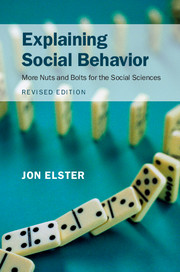Book contents
- Frontmatter
- Dedication
- Contents
- Preface
- I Explanation and Mechanisms
- II The Mind
- III Action
- IV Interaction
- 17 Unintended consequences
- 18 Strategic interaction
- 19 Games and behavior
- 20 Trust
- 21 Social norms
- 22 Collective belief formation
- 23 Collective action
- 24 Collective decision making
- 25 Institutions and constitutions
- Conclusion: is social science possible?
- Index
17 - Unintended consequences
from IV - Interaction
Published online by Cambridge University Press: 05 August 2015
- Frontmatter
- Dedication
- Contents
- Preface
- I Explanation and Mechanisms
- II The Mind
- III Action
- IV Interaction
- 17 Unintended consequences
- 18 Strategic interaction
- 19 Games and behavior
- 20 Trust
- 21 Social norms
- 22 Collective belief formation
- 23 Collective action
- 24 Collective decision making
- 25 Institutions and constitutions
- Conclusion: is social science possible?
- Index
Summary
Unintended consequences of individual behavior
Things do not always turn out the way we intend. Many events occur unintentionally. Sometimes, the causes are trivial, as when we press the accelerator instead of the brake or hit the “delete” button by mistake. Some mechanisms are more systematic, however. While there can hardly be a “general theory of unintended consequences,” one can at least begin to compile a catalogue. I consider cases in which the consequences are not only unintended, but also unforeseen. Anticipated “side effects of action” are not intended for their own sake, especially if they are negative, but I shall not count them as “unintended consequences of action.”
Unintended consequences can arise from individual behavior as well as from social interaction. Beginning with the former, we can use a simple extension of the desire–opportunity framework that was set out in Chapter 10 (see Figure 10.1).
While actions are shaped by desires (or preferences), they can also shape desires. Thus in addition to the intended outcome of an action, there is sometimes an unintended one: a change of desire. Addiction is a good example. Under the influence of addictive drugs, people begin to discount the future more heavily, thus weakening the deterrence effect of the long-term harm from addiction. Had this effect been anticipated, it might have prevented the agent from embarking on the “primrose path” to addiction, but typically it is not. Similar phenomena are observed in more ordinary situations. I go to the party intending to have only two drinks so that I can drive home, but after the second drink my resolve dissolves in alcohol and I take a third one. Had I known, I might have taken one drink only.
The “endowment effect,” an implication of loss aversion (Chapter 14), also illustrates choice-induced but unintended preference change. Many goods acquire greater subjective value for the owner than they had before she bought them, as shown by the fact that her minimal selling price typically exceeds her maximal buying price by a factor ranging from 2 to 4. Experiments show that prospective buyers underestimate the minimal resale price they would accept, showing that the preference change is indeed unforeseen.
Information
- Type
- Chapter
- Information
- Explaining Social BehaviorMore Nuts and Bolts for the Social Sciences, pp. 297 - 307Publisher: Cambridge University PressPrint publication year: 2015
